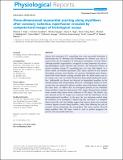| dc.contributor.author | Katz, Monica Y. | en_US |
| dc.contributor.author | Kusakari, Yoichiro | en_US |
| dc.contributor.author | Aoyagi, Hiroko | en_US |
| dc.contributor.author | Higa, Jason K. | en_US |
| dc.contributor.author | Xiao, Chun‐Yang | en_US |
| dc.contributor.author | Abdelkarim, Ahmed Z. | en_US |
| dc.contributor.author | Marh, Karra | en_US |
| dc.contributor.author | Aoyagi, Toshinori | en_US |
| dc.contributor.author | Rosenzweig, Anthony | en_US |
| dc.contributor.author | Lozanoff, Scott | en_US |
| dc.contributor.author | Matsui, Takashi | en_US |
| dc.date.accessioned | 2014-12-02T21:29:06Z | |
| dc.date.issued | 2014 | en_US |
| dc.identifier.citation | Katz, M. Y., Y. Kusakari, H. Aoyagi, J. K. Higa, C. Xiao, A. Z. Abdelkarim, K. Marh, et al. 2014. “Three‐dimensional myocardial scarring along myofibers after coronary ischemia–reperfusion revealed by computerized images of histological assays.” Physiological Reports 2 (7): e12072. doi:10.14814/phy2.12072. http://dx.doi.org/10.14814/phy2.12072. | en |
| dc.identifier.issn | 2051-817X | en |
| dc.identifier.uri | http://nrs.harvard.edu/urn-3:HUL.InstRepos:13454821 | |
| dc.description.abstract | Abstract Adverse left ventricular (LV) remodeling after acute myocardial infarction is characterized by LV dilatation and development of a fibrotic scar, and is a critical factor for the prognosis of subsequent development of heart failure. Although myofiber organization is recognized as being important for preserving physiological cardiac function and structure, the anatomical features of injured myofibers during LV remodeling have not been fully defined. In a mouse model of ischemia–reperfusion (I/R) injury induced by left anterior descending coronary artery ligation, our previous histological assays demonstrated that broad fibrotic scarring extended from the initial infarct zone to the remote zone, and was clearly demarcated along midcircumferential myofibers. Additionally, no fibrosis was observed in longitudinal myofibers in the subendocardium and subepicardium. However, a histological analysis of tissue sections does not adequately indicate myofiber injury distribution throughout the entire heart. To address this, we investigated patterns of scar formation along myofibers using three‐dimensional (3D) images obtained from multiple tissue sections from mouse hearts subjected to I/R injury. The fibrotic scar area observed in the 3D images was consistent with the distribution of the midcircumferential myofibers. At the apex, the scar formation tracked along the myofibers in an incomplete C‐shaped ring that converged to a triangular shape toward the end. Our findings suggest that myocyte injury after transient coronary ligation extends along myofibers, rather than following the path of coronary arteries penetrating the myocardium. The injury pattern observed along myofibers after I/R injury could be used to predict prognoses for patients with myocardial infarction. | en |
| dc.language.iso | en_US | en |
| dc.publisher | Wiley Periodicals, Inc. | en |
| dc.relation.isversionof | doi:10.14814/phy2.12072 | en |
| dc.relation.hasversion | http://www.ncbi.nlm.nih.gov/pmc/articles/PMC4187547/pdf/ | en |
| dash.license | LAA | en_US |
| dc.subject | 3D Imaging | en |
| dc.subject | animals | en |
| dc.subject | ischemia–reperfusion | en |
| dc.subject | LV remodeling | en |
| dc.subject | myofiber | en |
| dc.title | Three‐dimensional myocardial scarring along myofibers after coronary ischemia–reperfusion revealed by computerized images of histological assays | en |
| dc.type | Journal Article | en_US |
| dc.description.version | Version of Record | en |
| dc.relation.journal | Physiological Reports | en |
| dash.depositing.author | Rosenzweig, Anthony | en_US |
| dc.date.available | 2014-12-02T21:29:06Z | |
| dc.identifier.doi | 10.14814/phy2.12072 | * |
| dash.authorsordered | false | |
| dash.contributor.affiliated | Rosenzweig, Anthony | |


